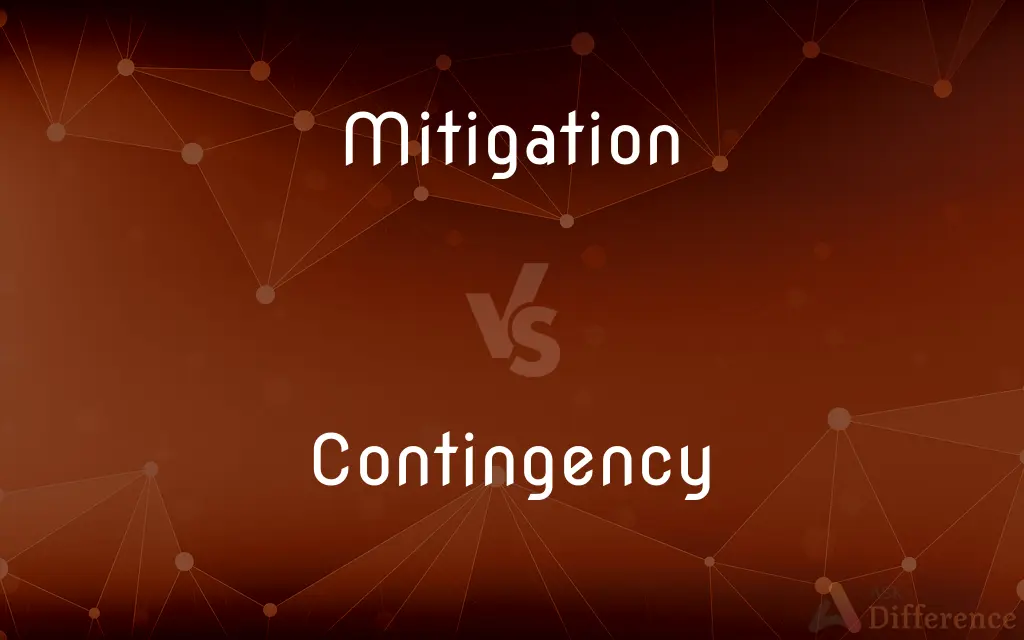Mitigation vs. Contingency — What's the Difference?
By Fiza Rafique & Maham Liaqat — Updated on April 16, 2024
Mitigation involves proactive measures to reduce risks, focusing on prevention, while contingency planning entails preparing responses for potential future scenarios.

Difference Between Mitigation and Contingency
Table of Contents
ADVERTISEMENT
Key Differences
Mitigation strategies are implemented to reduce the likelihood or impact of a risk event, aiming at prevention and early intervention. Whereas, contingency planning is more about preparing responses to deal with the consequences if the risk event occurs.
Mitigation can involve long-term planning to avoid potential threats or minimize their effects on an ongoing basis. On the other hand, contingency plans are often developed to be executed only if a specific risk materializes.
Mitigation is generally considered a part of strategic planning, integral to the management of any project or operation from the beginning. Whereas, contingency is typically a reactive strategy, coming into play when mitigation measures are insufficient or fail.
Mitigation efforts might include training, safety measures, and policies to avoid risks. While, contingency measures could include backup systems, emergency funds, or detailed recovery plans.
Mitigation seeks to alter how operations are conducted to integrate risk considerations, reducing the need for emergency measures. In contrast, contingency planning accepts the possibility of risks materializing and focuses on effective response and recovery.
ADVERTISEMENT
Comparison Chart
Definition
Actions taken to reduce or eliminate risk before it occurs
Plans prepared to respond to an event if it occurs
Focus
Prevention and reduction
Response and recovery
Nature
Proactive
Reactive
Implementation
Throughout the project or process
Activated as needed
Examples
Safety training, quality control
Emergency plans, backup systems
Compare with Definitions
Mitigation
Efforts to reduce risk impact or likelihood.
Implementing strict quality control can mitigate manufacturing errors.
Contingency
Response strategies for unexpected events.
A company may have a power outage contingency plan.
Mitigation
Adoption of safety measures to prevent incidents.
Regular fire drills mitigate risks associated with fire emergencies.
Contingency
Backup systems to ensure continuity.
Hospitals have contingency plans that include backup generators.
Mitigation
Implementing policies that discourage harmful practices.
Enforcing environmental regulations mitigates pollution.
Contingency
Emergency procedures activated upon an event.
Evacuation plans are a contingency for natural disasters.
Mitigation
Changes in process to avoid potential threats.
Encrypting data mitigates the risk of cyber attacks.
Contingency
Plans developed for potential future incidents.
Businesses create contingency plans for IT system failures.
Mitigation
Strategic decisions to lower chances of adverse outcomes.
Diversifying investment portfolios mitigates financial risk.
Contingency
Funds reserved for unexpected needs.
Setting aside a contingency fund helps handle unforeseen expenses.
Mitigation
To make less severe or intense; moderate or alleviate.
Contingency
A future event or circumstance which is possible but cannot be predicted with certainty
A detailed contract which attempts to provide for all possible contingencies
Mitigation
To make alterations to (land) to make it less polluted or more hospitable to wildlife.
Contingency
An event that may occur but that is not likely or intended; a possibility.
Mitigation
A reduction or decrease of something harmful or unpleasant.
Contingency
A possibility that must be prepared for; a future emergency.
Mitigation
The act of mitigating, or the state of being mitigated; abatement or diminution of anything painful, harsh, severe, afflictive, or calamitous; as, the mitigation of pain, grief, rigor, severity, punishment, or penalty.
Contingency
The condition of being dependent on chance; uncertainty.
Mitigation
To act in such a way as to cause an offense to seem less serious
Contingency
Something incidental to something else.
Mitigation
A partial excuse to mitigate censure; an attempt to represent an offense as less serious than it appears by showing mitigating circumstances
Contingency
(uncountable) The quality of being contingent, of happening by chance.
Contingency
(countable) A possibility; something which may or may not happen. A chance occurrence, especially in finance, unexpected expenses.
Contingency
An amount of money which a party to a contract has to pay to the other party (usually the supplier of a major project to the client) if he or she does not fulfill the contract according to the specification.
Contingency
A statement which is neither a tautology nor a contradiction.
Contingency
Union or connection; the state of touching or contact.
Contingency
The quality or state of being contingent or casual; the possibility of coming to pass.
Aristotle says we are not to build certain rules on the contingency of human actions.
Contingency
An event which may or may not occur; that which is possible or probable; a fortuitous event; a chance.
The remarkable position of the queen rendering her death a most important contingency.
Contingency
An adjunct or accessory.
Contingency
A certain possible event that may or may not happen, by which, when happening, some particular title may be affected.
Contingency
A possible event or occurrence or result
Contingency
The state of being contingent on something
Common Curiosities
What is the primary goal of mitigation?
To prevent risks from occurring or reduce their impact.
Why is it important to have both mitigation and contingency plans?
To comprehensively manage risks by both preventing them and preparing for their possible occurrence.
Can you give an example of a mitigation technique?
Regular system updates to prevent security breaches.
How does contingency planning differ from mitigation?
Contingency planning prepares specific responses for risks that might occur, while mitigation tries to prevent these risks.
What might a typical contingency plan include?
Emergency contact information, resources allocation, and response steps.
What role does contingency play in risk management?
It provides a prepared response option if initial risk management strategies fail.
How do mitigation and contingency plans impact business continuity?
They ensure that operations can continue during and after adverse events.
Is mitigation always effective?
Not always; hence the need for robust contingency plans.
When should mitigation strategies be developed?
At the planning phase of a project or operation to integrate risk considerations early.
What is an example of a contingency plan for a natural disaster?
An evacuation plan and established relief resource allocations.
Can mitigation include insurance policies?
Yes, purchasing insurance is a form of risk mitigation.
What could be considered a financial contingency plan?
Having a reserve budget or emergency fund.
How often should contingency plans be reviewed?
Regularly, to ensure they are up to date and applicable to current conditions.
Share Your Discovery

Previous Comparison
Unquote vs. Enquote
Next Comparison
Char vs. ChatAuthor Spotlight
Written by
Fiza RafiqueFiza Rafique is a skilled content writer at AskDifference.com, where she meticulously refines and enhances written pieces. Drawing from her vast editorial expertise, Fiza ensures clarity, accuracy, and precision in every article. Passionate about language, she continually seeks to elevate the quality of content for readers worldwide.
Co-written by
Maham Liaqat














































